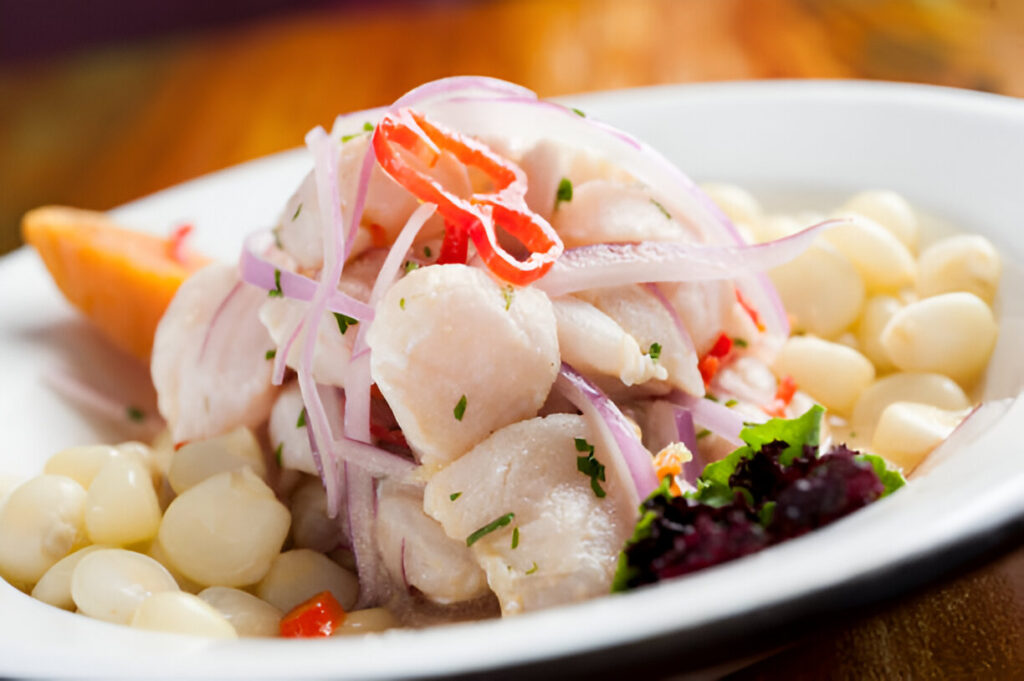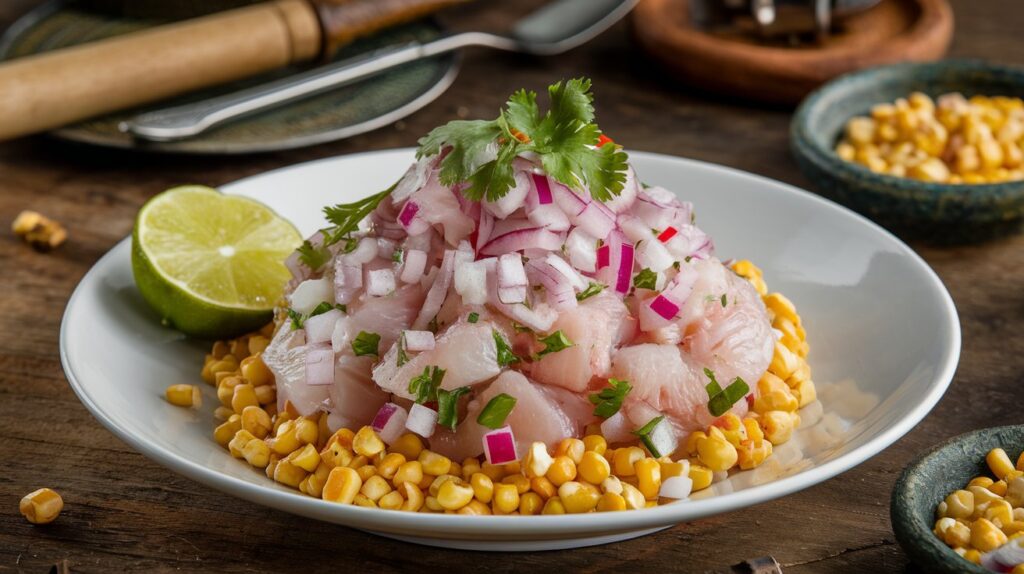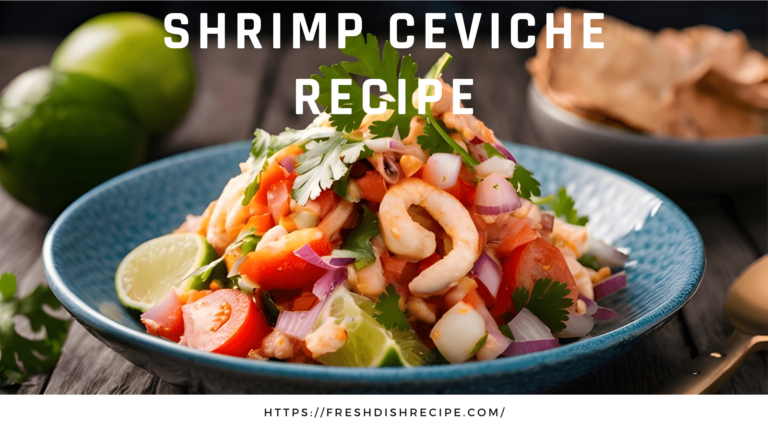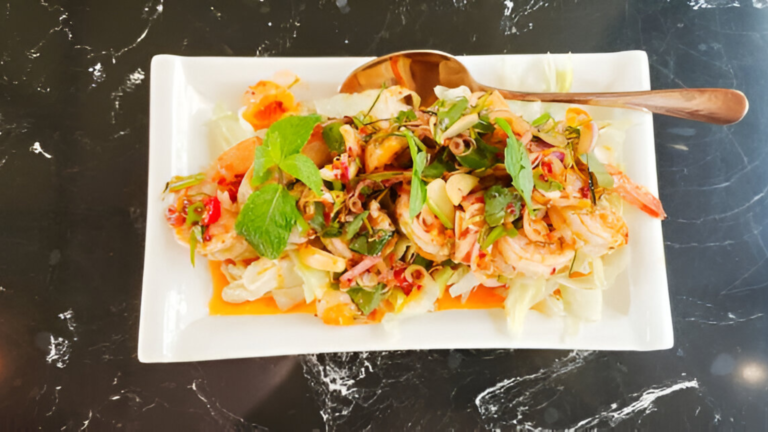Table of Contents
Discover the essence of Peruvian ceviche, a classic dish that perfectly marries the freshness of fish with the vibrant zing of lime juice. This beloved seafood delicacy has transcended borders, captivating palates worldwide.
No trip to Peru is complete without indulging in this traditional culinary masterpiece. In this blog, you’ll learn everything there is to know about ceviche—from its fascinating history and diverse recipes to the top ceviche restaurants in Peru where you can savor authentic flavors crafted by master chefs. Join us on a flavorful journey that celebrates this iconic dish and its global influence!

What Is Ceviche
Ceviche, a refreshing and zesty seafood dish, is a beloved staple across Latin America, also known by names like cebiche, cebiche, or seviche. While its origins are debated, there’s a strong consensus that this vibrant dish has deep roots in Peru.
The Traditional ceviche recipe is traditionally made with a firm white fish, such as sea bass, marinated in freshly squeezed lime or bitter orange juice. It’s then combined with thinly sliced onions, fiery chili peppers, and a pinch of salt. This flavorful mix is often served with an array of accompaniments, including giant Peruvian corn, tender slices of sweet potato, crispy plantain chips (chifles), and toasted corn nuts (cancha), creating a perfect balance of textures and tastes.

The History of Peruvian Ceviche
Ceviche, a dish inseparable from Peruvian cooking, flaunts a rich and complex history that mirrors the different social impacts of the district. Its starting points can be traced back more than 2,000 years to the Moche civilization in northern Peru, where it is accepted that crude fish was marinated utilizing the matured juice of nearby organic products, for example, banana passionfruit. This antiquated practice laid the foundation for the ceviche we know today.
During the Inca Empire, the preparation of ceviche advanced further, with native networks using chicha, an Andean-aged drink, to marinate fish. This technique displayed the creativity of the Inca in preserving and enhancing fish. The appearance of Spanish conquerors in the sixteenth century presented new ingredients, for example, onions and citrus organic products, which enhanced the dish’s flavor profile and added to its far-reaching ubiquity across Latin America.
The expression “ceviche” itself has different proposed starting points. Some propose it comes from the Latin word cibus, signifying “food,” while others interface it to the Arabic word for vinegar or the Spanish expression “escabeche,” which signifies “pickle.” Since the beginning of time, ceviche has been known by various names, including cebiche and seviche, reflecting territorial varieties and etymological impacts.
Today, ceviche is commended as Peru’s national dish, perceived for its dynamic flavors and social importance. It has risen above borders, moving endless varieties in nations like Ecuador, Chile, and Mexico, each adding its extraordinary bend to this darling fish delicacy. Ceviche keeps on being an image of culinary pride in Peru, respected every year on National Ceviche Day on June 28, displaying its getting through heritage in the realm of gastronomy.

How to Make Authentic Peruvian Ceviche
To Make a “Peruvian Ceviche Recipe“, follow this detailed recipe that highlights the freshness and vibrant flavors characteristic of this beloved dish.
Ingredients List
- Fresh fish: 1 pound (e.g., sea bass, flounder, or sole), cut into 1/2-inch cubes
- Lime juice: 2/3 cup (freshly squeezed)
- Red onion: 1 small, thinly sliced
- Ají peppers: 1 ají limo or habanero, seeded and finely chopped (adjust to taste)
- Salt: to taste
- Additional ingredients for serving:
- 1 small sweet potato, boiled and cut into rounds
- 1 ear of corn, boiled and cut into rounds
- Fresh cilantro leaves for garnish
Step-by-Step Recipe
- Preparation of Fish and Vegetables:
- Start by cutting the fresh fish into bite-sized cubes and place them in a large mixing bowl.
- Thinly slice the red onion and add it to the bowl with the fish.
- Marinating Process:
- In a separate bowl, combine the lime juice, chopped ají pepper, and salt. Mix well.
- Pour the lime juice mixture over the fish and onions, ensuring that all pieces are well coated.
- Let the mixture marinate for about 2-3 minutes. The acidity of the lime juice will “cook” the fish, turning it opaque.
- Serving Suggestions:
- While the ceviche is marinating, prepare the side dishes. Boil the sweet potato until tender, then slice it into rounds. Boil the corn and cut it into rounds as well.
- Once marinated, serve the ceviche immediately in a deep dish, garnished with fresh cilantro. Accompany it with the boiled sweet potato and corn on the side.

Best Fish for Ceviche Peruano
The best fish for making “authentic Peruvian ceviche” includes several varieties that are known for their freshness and firm texture. Here are some of the top choices:
- Sea Bass: This is one of the most popular choices for ceviche due to its mild flavor and firm flesh, which absorbs the marinade well.
- Flounder: Another excellent option, flounder has a delicate taste and a tender texture that works beautifully in ceviche.
- Corvina: A traditional fish used in Peruvian ceviche, corvina is prized for its sweet flavor and firm texture, making it ideal for marinating.
- Mahi-Mahi: This fish is also commonly used and offers a slightly stronger flavor while still being firm enough for ceviche.
- Halibut: Known for its mild taste and firm texture, halibut is a great choice for those looking for a richer flavor profile.
- Red Snapper: This fish provides a slightly sweeter taste and is often used in ceviche for its vibrant color and texture.
- Scallops: While not a fish, fresh scallops are a delicious alternative for ceviche, offering a sweet and tender bite.

Tips for Making the Perfect Ceviche
Making the perfect Peruvian ceviche, consider these essential tips that will enhance the flavor and ensure authenticity:
Tips for Making the Perfect Peruvian Ceviche
- Use Fresh Fish:
- Balance Flavors:
- Marinate for the Right Time:
- Prepare Ingredients Properly:
- Use Quality Lime Juice:
- Experiment with Ají Peppers:
- Serve Immediately:
- Garnish Thoughtfully:
By following these tips, you’ll be well on your way to creating a delicious and authentic Peruvian ceviche that captures the essence of this iconic dish.

Ceviche in Peruvian Culture
Ceviche holds a special place in Peruvian culture, transcending its status as a mere dish and becoming a symbol of national identity and culinary pride. This iconic seafood creation is deeply rooted in Peru’s history, traditions, and coastal way of life.
A National Treasure
In 2004, the Peruvian government recognized the cultural significance of ceviche by declaring it a Cultural Heritage of the Nation. This prestigious designation underscores the dish’s importance in Peruvian cuisine and its role in shaping the country’s culinary identity.
Celebrating National Ceviche Day
Every June 28th, Peru celebrates National Ceviche Day, a testament to the nation’s love affair with this refreshing seafood dish. This annual celebration brings together Peruvians from all walks of life to honor their culinary heritage and indulge in the flavors that define their coastal cuisine.
Ceviche as a Unifying Force
Beyond its gastronomic appeal, ceviche serves as a unifying force in Peruvian culture. Sharing a plate of ceviche is a social ritual that transcends class, age, and regional boundaries. It is a dish that brings families and friends together, fostering a sense of community and shared identity.
Ceviche Festivals and Events
Throughout Peru, numerous festivals and events are dedicated to celebrating the art of ceviche-making. From the bustling fish markets of Callao to the sun-drenched beaches of Lima, these gatherings showcase the diversity of ceviche recipes and the skill of local chefs. These events not only promote culinary tourism but also reinforce the cultural significance of ceviche in Peruvian society.
Ceviche as a Symbol of Coastal Life
Ceviche is more than just a dish; it is a reflection of Peru’s coastal way of life. The freshness of the fish, the zest of the lime, and the heat of the chili pepper all come together to create a flavor profile that is quintessentially Peruvian. In a sense, ceviche is a taste of the ocean, a whisper of the Andean winds, and a brush with the Peruvian sun, all encapsulated in a single bite.
Conclusion:
Peruvian ceviche stands out as a refreshing and vibrant dish that captures the essence of Latin American cuisine. With its delicate balance of fresh fish, tangy citrus, and spicy peppers, it’s no wonder ceviche has gained global popularity. Whether enjoyed as a light appetizer or a flavorful main course, Peruvian ceviche offers a taste of tradition that’s both satisfying and unforgettable. For food lovers exploring authentic Latin American flavors, ceviche is a must-try dish that brings the rich culinary heritage of Peru to life.
Join our culinary community for more ceviche adventures! Subscribe to our blog for the latest recipes and trends. Follow us on social media to share your ceviche experiences and engage with fellow enthusiasts. Comment below to share your thoughts, recipes, and tips. Help us celebrate the flavors and cultural significance of Peruvian ceviche by spreading the word!
FAQs about Peruvian Ceviche
1. What is Peruvian ceviche?
Peruvian ceviche is a traditional dish made from fresh, raw fish marinated in lime juice, combined with ingredients like red onion, ají peppers, and cilantro. The acidity of the lime juice “cooks” the fish, resulting in a refreshing and flavorful dish that is a staple of Peruvian cuisine.
2. What types of fish are best for ceviche?
The best fish for ceviche include firm, fresh varieties such as sea bass, flounder, corvina, and mahi-mahi. It’s crucial to use sushi-grade fish to ensure safety and quality.
3. When is ceviche traditionally served?
Ceviche is typically enjoyed for lunch in Peru, ideally before 3 PM. It is considered a dish that should be made with the freshest seafood, often caught the same morning.
4. How is ceviche prepared?
To prepare ceviche, the fish is cut into bite-sized pieces and marinated in lime juice along with sliced onions and ají peppers. The mixture is allowed to marinate for a short period, usually 2-3 minutes, before serving.
5. What are common accompaniments to ceviche?
Ceviche is often served with sides such as boiled sweet potatoes, corn (choclo), and lettuce. These accompaniments add texture and balance to the dish.







